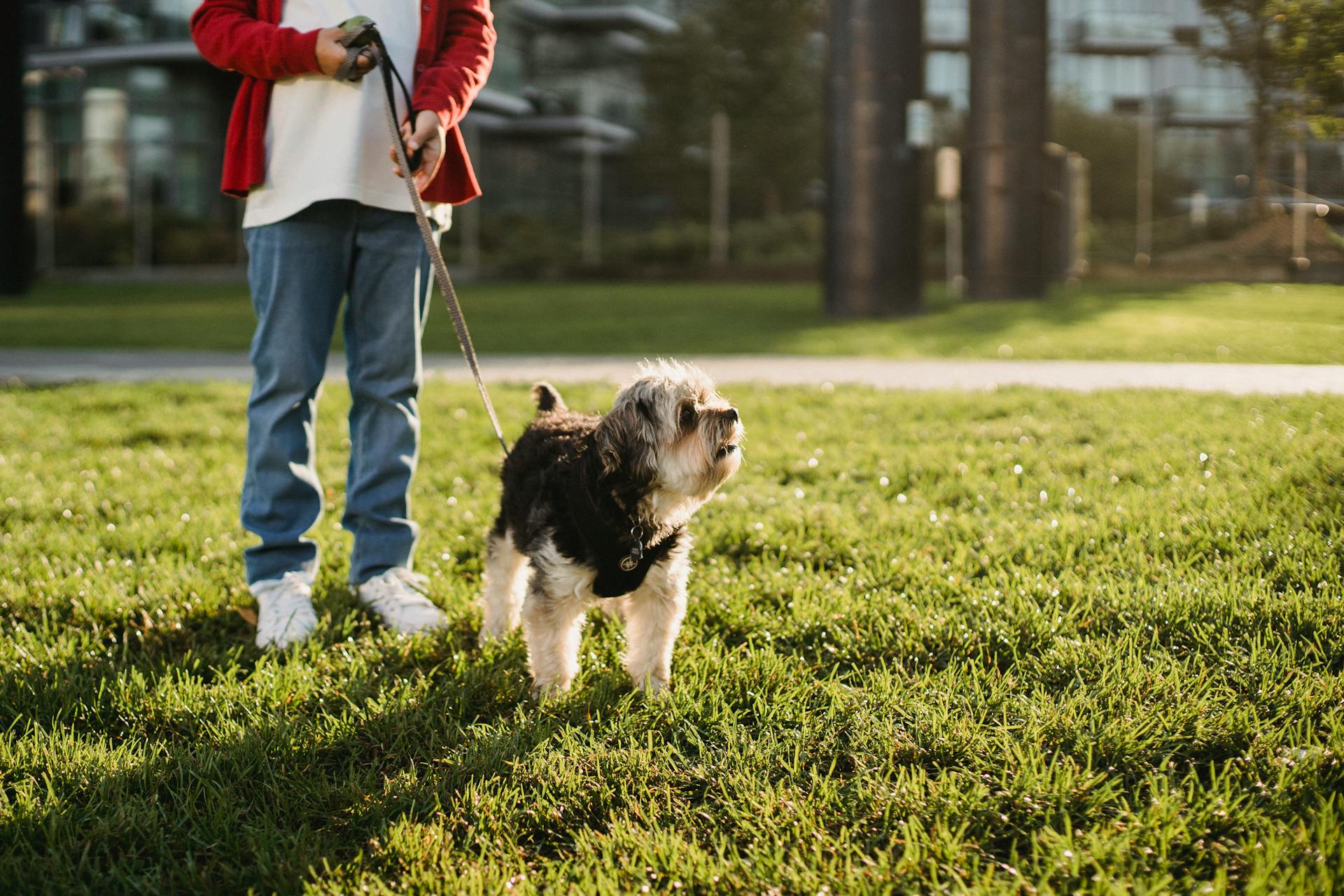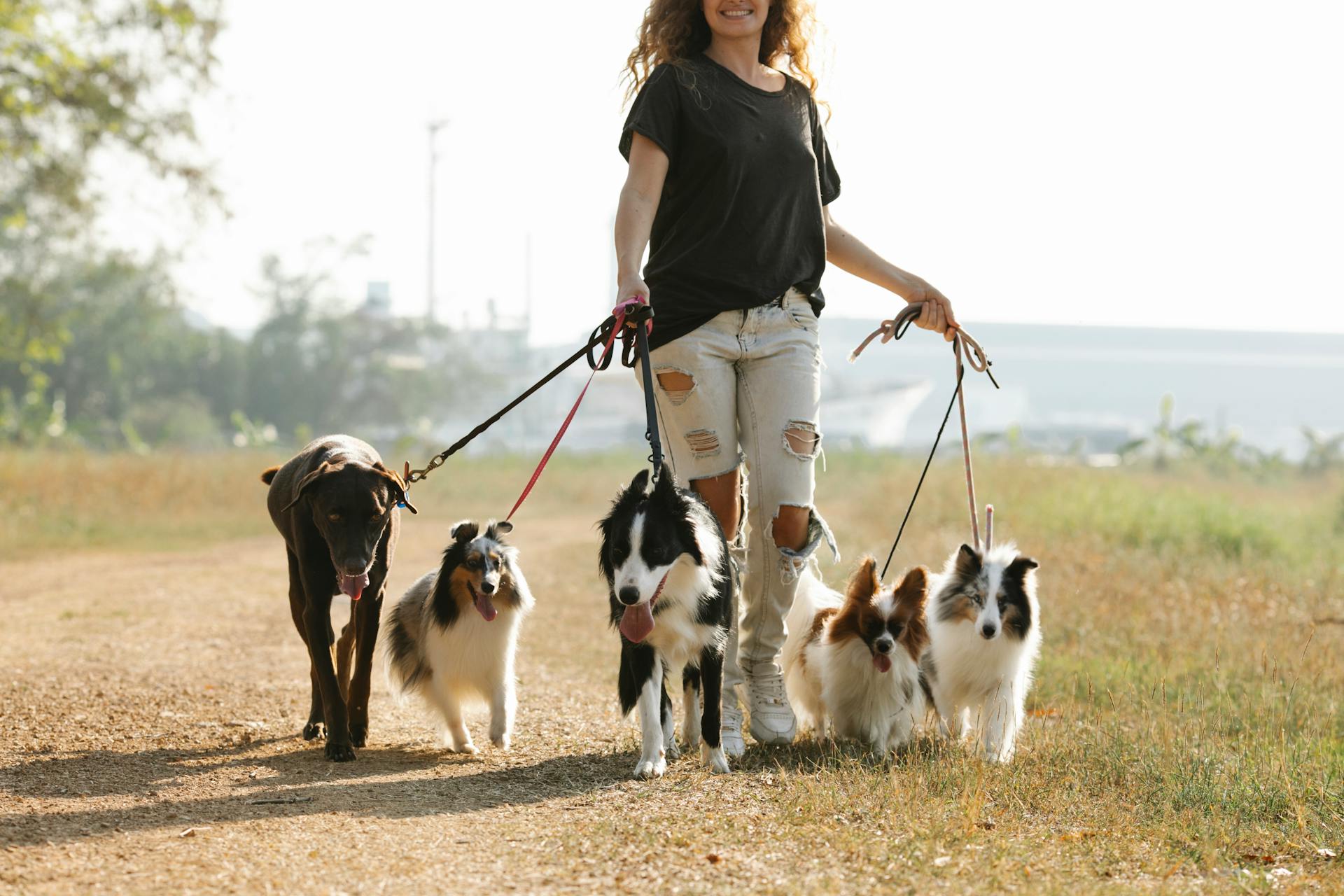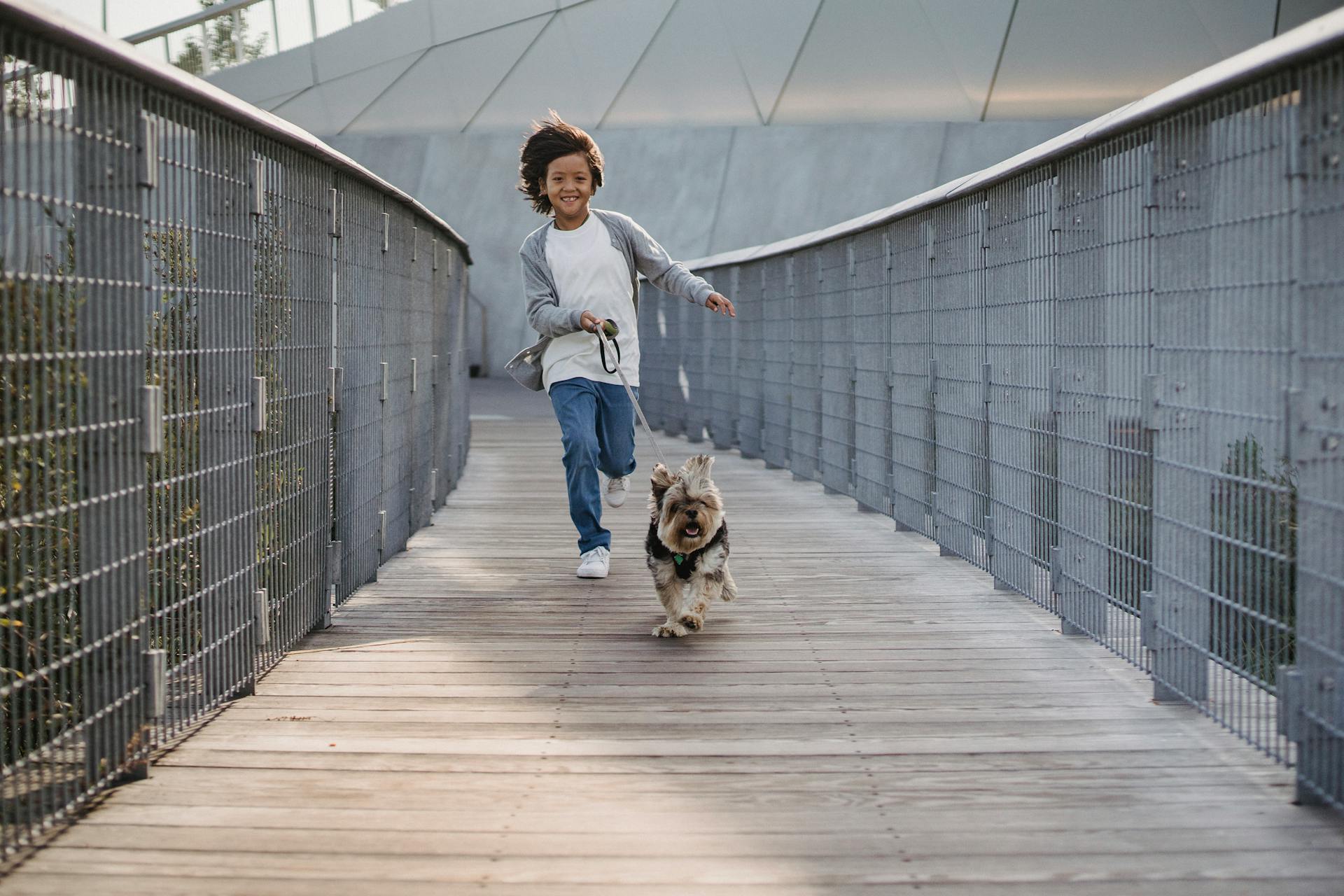
Long leash dog training is a great way to socialize your dog and teach them basic obedience skills. This type of training is ideal for puppies and dogs that need to practice walking on a leash without getting overwhelmed.
A long leash is typically 20-25 feet long, which gives your dog more freedom to move around while still allowing you to maintain control. This is especially helpful for dogs that tend to pull on the leash.
To start long leash training, find a quiet area with minimal distractions where your dog can focus on you. Begin by having your dog wear a harness and attach the leash to it, rather than their collar.
Benefits and Preparation
Long leash dog training offers numerous benefits, including reducing undesirable hunting behavior and improving leash training. This method is ideal for puppies, allowing them to run free in places where a leash is required.
With a long leash, you can avoid hazards such as poisoned bait and train your dog to come when called from a distance. This level of control is crucial for confident training.
Walking with a dog who has good leash manners is much more pleasant than dealing with a dog who pulls on leash. Regular outings to new places help keep your dog's mind happily occupied.
A long leash provides opportunities for exercise and outdoor time, benefiting both you and your dog. You'll likely get more walking in yourself, and your dog will get cardiovascular benefits from walking.
Here are some benefits of long leash training:
- Reduces undesirable hunting behavior
- Leash training is improved
- Ideal training method for puppies
- Dogs can run free in places where a leash is required
- Hazards such as poisoned bait are easier to avoid
- Control your pet from a distance
- You can more confidently train your dog to come when called
Training Techniques
Leash training a puppy to heel is useful for short periods when you need him very close to you and attentive to you.
Start by practicing in your home, where your dog is most comfortable, to build a strong foundation for long leash training. Place a treat in your fist and let him sniff it, then say "let's go" and take a couple of steps while leading him along with the treat in your fist near your thigh.
Intriguing read: Dog Treat Training
Praise and reward him with a treat when he is following your fist with his nose, as this will help him associate the command with the desired behavior.
Continue to practice having your dog follow your empty fist, praising and rewarding him for every couple of steps that he follows your fist.
As you progress, increase your standards with each session, and remember to try this outside and in more distracting circumstances to help your dog generalize the behavior.
A unique perspective: Does Neutering a Dog Stop Aggression
Harness and Equipment
To start harness and equipment training, you'll need a few essential supplies. Gather a quality 6-foot leash that feels good in your hand, dog poop bags and a poop bag holder, and a well-fitted dog harness.
A well-fitted dog harness is crucial for comfort and safety. Avoid using retractable leashes, as they can be confusing for some dogs due to their constant pulling effect.
You can also opt for a "hands-free" option using a long lead in a "hands-free leash" setup. This is ideal for times where you want your dog to be attached to you, but also want to be able to use your arms to engage in play.
Here are the supplies you'll need for leash training:
- Training treats to use as rewards
- A quality 6-foot leash
- Dog poop bags and a poop bag holder
- A well-fitted dog harness
Equipment First: Pick Right

A good harness is essential for leash training, so make sure to get one that fits your dog well.
A quality 6-foot leash that feels good in your hand is also a must-have, and it's best to avoid using a retractable leash.
Dog poop bags and a poop bag holder are necessary for cleaning up after your dog's walks.
You can choose a front-clip harness, which can be gentler on your dog's neck and less likely to cause injury.
If your dog is prone to pulling, a front-clip harness can be especially helpful.
A well-fitted dog harness is a key part of leash training, and it's a good idea to get one that comes with both types of clips.
Here are the essential supplies you'll need for leash training:
- Training treats to use as rewards
- A quality 6-foot leash that feels good in your hand
- Dog poop bags and a poop bag holder
- A well-fitted dog harness
The "thumb loop" technique for holding a long leash is a safer and more controlled way to walk your dog, and it's worth learning.
Hands Free Option Available
You can opt for a "hands free" option when using your dog's long lead. This is ideal for times where you want your dog to be attached to you but also want to be able to use your arms to engage in play, like a game of tug.
You can connect the long line to your waist via a fanny pack, treat pouch, or carabiner on a belt loop. This setup is perfect for hands-free leash use.
Managing the slack in the leash is still important even with a hands-free setup. You'll want to make sure the leash doesn't get tangled and that you have secure control over your dog's motion.
Here are some common ways to manage the slack in a hands-free leash setup:
- Fanny pack: Attach the leash to a fanny pack on your waist.
- Treat pouch: Connect the leash to a treat pouch on your belt loop.
- Carabiner: Use a carabiner to attach the leash to your belt loop.
It's essential to experiment with different methods to find what works best for you and your dog.
Use Two Hands to Manage
Using two hands to manage your dog's leash is a game-changer for training and everyday walks. You always want to have both hands on the leash, with one acting as an anchor to prevent losing your grip and the other managing slack to keep your dog from running too quickly.
For example, holding the leash with one hand and letting it leash along the ground with the other is a great way to start. This setup allows you to have control over your dog's motion while also giving them some freedom to move around.
Experiment with what feels best for you, but remember that the leash shouldn't get tangled and you should have secure control over your dog's movement.
Take a look at this: Impulse Control Dog Training
Exercises
To effectively train your dog using a long leash, you'll want to try out several exercises to help them learn to respond to your commands. Start by practicing recall training in a safe, enclosed environment.
Recall training is a crucial aspect of long leash dog training, and it's essential to begin in a controlled environment. To start, attach the long leash to your dog's harness and let them pull it behind you while you hold the leash. Take a few steps back and call your dog to you in a friendly and firm manner.
Discover more: Training Recall Dog
Use positive reinforcement, such as praise or rewards, when your dog responds to your call and comes to you. If they don't respond immediately, gently tug on the long leash to get their attention. Repeat this exercise regularly and slowly increase the distance between you and your dog.
Another exercise you can try is the "Stop and Reward" method. This involves stopping moving forward when your dog pulls on the leash and rewarding them with treats when they walk by your side. A treat bag for your waist can be very helpful in this exercise.
You can also try the "Long Leash Radio Training" exercise, which involves walking slowly to the edge of a demarcated area and calling your dog back to you when they reach the boundary. Use positive reinforcement and gradually increase the radius in which your dog is allowed to move freely.
Here are some key tips to keep in mind as you practice these exercises:
- Be patient and consistent in your training.
- Use positive reinforcement, such as praise and rewards.
- Gradually increase the distance and distractions as your dog becomes more reliable.
- Avoid punishing your dog for mistakes.
- Use a long leash that is approximately 5 meters long, depending on the weight and size of your dog.
By following these exercises and tips, you can help your dog learn to respond to your commands and walk by your side using a long leash.
Tips and Best Practices
Before you start long leash dog training, it's essential to reduce your dog's energy level with some playtime in the yard. This will help them focus better during training.
To get your dog's attention while leash training outside the home, use high-value treats that they only get during these sessions. This will make them more receptive to your guidance.
Taking your dog on walks just for sniffing can be a great way to help them set the pace and direction. This approach allows them to explore their surroundings without feeling restricted.
Longer leashes can give your dog a sense of freedom and decrease pulling by removing resistance to their movements.
To reinforce good behavior, be sure to reward your dog every time they pay attention to you while on leash.
Here are some key things to keep in mind when leash training your dog:
Troubleshooting and Prerequisites
If your puppy is crossing in front of you while leash training, stomp or shuffle your feet a bit to make your presence more obvious. This simple action can help your dog feel more secure and attentive.
If your puppy is lagging behind, it's possible they're frightened or not feeling well, so use lots of encouragement instead of pulling them along. If they're lagging to sniff or potty, simply keep walking and apply gentle pressure on the leash.
To use a long line effectively, your dog should have a few essential skills in place. These include the ability to pay attention to you around mild to moderate distractions, walking on a relatively loose leash, and casual recall where they can make eye contact and return within a few feet of you when called.
Here are some key prerequisites for long line training:
- Ability to pay attention to you around mild to moderate distractions.
- Walking on a relatively loose leash.
- Casual recall where your dog can make eye contact and return within a few feet of you if you call their name.
Pulling Injuries
Pulling on the leash can lead to injuries for both you and your dog. Common injuries include strained neck and back muscles from yanking the dog back.
Avoiding yelling, yanking the dog back, or giving collar pops can help prevent injuries. This approach is more effective than trying to force your dog to walk calmly.
If your dog pulls on the leash, it's essential to evaluate the training and environment. Places with lots of activity, like a farmer's market or near a dog park, can trigger pulling due to excitement or curiosity.
Discover more: How to Stop Staffy Pulling on Lead
Troubleshooting
Troubleshooting is an essential part of the leash training process. If your puppy is crossing in front of you, stomp or shuffle your feet a bit to make your presence more obvious.
If your puppy is lagging behind a great deal, it could be a sign that they're frightened or not feeling well. In this case, use lots of encouragement instead of pulling them along. If they're lagging to sniff or to potty, simply keep walking, but be sure to apply only gentle pressure on the leash.
Don't forget to use lots of rewards when your puppy walks with you. If your puppy is alternating between walking beside you and pulling, stop rewarding them for coming back towards you after they pull. Instead, concentrate on rewarding them for taking a larger number of consecutive steps by your side.
A different take: Dogs Walking Backwards
When in Doubt, Seek Professional Help
If you're experiencing issues with your dog's leash, don't hesitate to seek help from a professional dog trainer. They can teach you how to manage your dog's leash in a safe and fun way.

Certified force-free professionals are not just trainers for dogs, but also for humans. They can help you learn new skills and techniques to improve your interactions with your dog.
An experienced dog trainer can help you identify and address underlying issues that might be causing problems with your dog's behavior. They can also teach you how to teach necessary skills to your dog in a way that's enjoyable for both of you.
A professional dog trainer can be a valuable resource when you're unsure about how to proceed with training your dog. They can provide you with personalized guidance and support to help you overcome challenges and achieve your goals.
For more insights, see: Will Spaying a Dog Help with Aggression
Prerequisites for Using a Line
Before you start using a long line with your dog, there are some essential prerequisites to consider.
To begin with, your dog should have a basic level of obedience skills. This includes being able to pay attention to you in mildly distracting environments. Think of it like this: if you're walking your dog in a park and you call out to a friend, your dog should be able to focus on you and not get too distracted.

A good starting point is to ensure your dog can walk on a relatively loose leash. You don't need perfection, but it's essential that your dog is aware of your presence and won't pull you over. Initial leash training is a must before opting for a long line.
Another crucial skill is casual recall. This means your dog can make eye contact and return to you within a few feet if you call their name. This is a fundamental aspect of obedience training, and it's essential for using a long line.
Here are the specific skills your dog should have before using a long line:
- Ability to pay attention to you around mild to moderate distractions.
- Walking on a relatively loose leash.
- Casual recall where your dog can at least make eye contact and return within a few feet of you if you call their name.
By having these skills in place, you'll be better equipped to handle situations where your dog might get distracted or pull on the leash.
Frequently Asked Questions
Are long training leashes good for dogs?
Yes, long training leashes provide a safe and effective way to give your dog more freedom while practicing recall training. They're an ideal step towards off-leash freedom and can help strengthen your bond with your dog.
How long of a leash for long leash training?
For long leash training, consider a leash between 15' to 150' in length, ideal for field training, socialization, and teaching basic commands like "come" and "stay
Is it OK to walk your dog on a long leash?
Yes, a long leash is suitable for walking your dog in public areas, helping to keep them close and reduce pulling. It's ideal for parks, crowded neighborhoods, and cities.
Sources
- https://be.chewy.com/leash-train-dog-2/
- https://petexpertise.com/blogs/dog-leash/dog-training-article-training-your-dog-not-to-pull-on-the-leash
- https://www.petmd.com/dog/general-health/how-to-leash-train-dog
- https://www.hundeo.com/en/training/walk-on-a-leash/
- https://www.sniffspot.com/blog/dog-training/how-to-long-leash-train-your-dog
Featured Images: pexels.com


